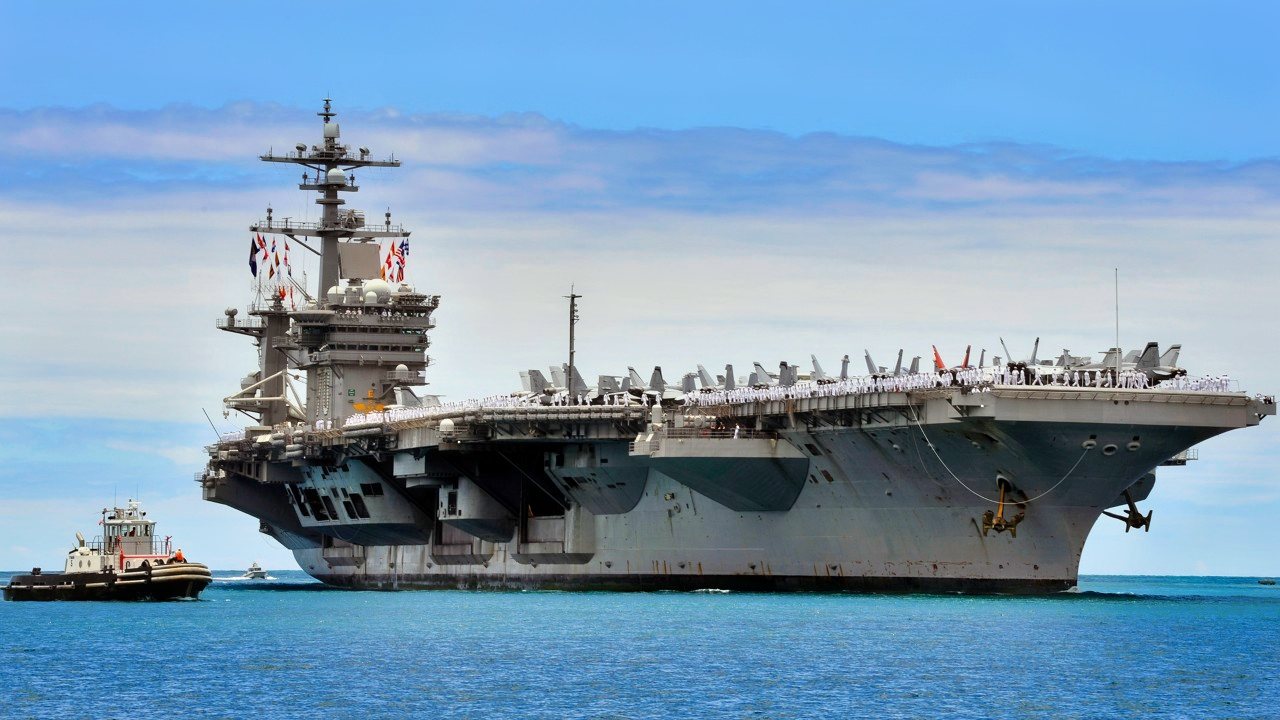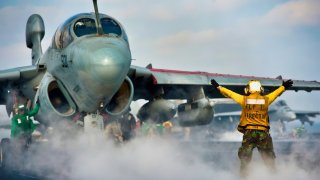USS United States: The Aircraft Carrier Designed to Launch Bombers
The USS United States (CVA-58) was a proposed nuclear-powered aircraft carrier designed to revolutionize naval capabilities by launching Air Force nuclear bombers.
Summary: The USS United States (CVA-58) was a proposed nuclear-powered aircraft carrier designed to revolutionize naval capabilities by launching Air Force nuclear bombers. Its design required a significantly altered deck to accommodate larger aircraft and lacked a traditional command island, posing numerous operational challenges.
-Additionally, the Air Force opposed sharing nuclear responsibilities with the Navy. Facing engineering hurdles and inter-service rivalry, the project was eventually canceled, leading to the resignation of Navy leaders in what became known as the "Admiral's Revolt."
-Ultimately, the Navy developed the Nimitz-class carriers, which better suited future needs without the complexities of the USS United States.
How the Ambitious USS United States Aircraft Carrier Project Led to the Admiral’s Revol
The USS United States (CVA-58) was a proposed nuclear-powered aircraft carrier that struggled to find support from the Pentagon, despite having initially received funding—so much so that the keel was laid down in 1949 for the great warship. The concept was for the Navy to not only make a quantum leap in its carrier capabilities by having a nuclear-powered system but to make that new warship a “bomber-carrier.”
Essentially, the United States would be large enough to house an airwing consisting of nuclear weapons bombers provided by the Air Force. The concept was designed to keep this class of carrier far removed from an enemy’s shoreline (because any potential nuclear weapons bomber would have greater range to go farther over enemy airspace, meaning that the carriers from where they launched could be kept away from any anti-ship missiles).
But, there were an assortment of problems with CVA-58, not least of which that the Air Force resented the Navy’s attempt to, as they saw it, impinge on their nuclear monopoly with this aircraft carrier.
Aircraft Carrier Engineering Problems
Another problem was the design of the carrier itself. The Navy had never built an aircraft carrier that had a nuclear reactor as its power source. Moreover, the Navy had to make the design of the flight deck itself fundamentally different from its previous successful aircraft carrier designs.
For starters, the United States needed to have a reinforced landing deck to accommodate the larger nuclear bombers that the Air Force would supposedly provide.
CVA-58 would need a longer and wider flight deck than any previous carrier as well. In fact, the nuclear bombers would be so much larger than what the Navy was used to hosting on their carriers that the bombers would not be able to be placed below the deck in the hangar.
Therefore, the flight deck would need to be big enough to accommodate those large nuclear bombers remaining in place up top when they weren’t flying while still having room for other warplanes to take off and land from the flight deck.
Another problem with the proposed design of the United States was the fact that, to accommodate the nuclear bombers with their longer wingspans, there would not be an “island” on the flight deck.
Instead, the command crew would be placed on a command ship and remotely coordinate launches and landings from that command ship.
Not only did this present problems in terms of running the ship—the captain would not actually be onboard the carrier, for instance—but the islands on an aircraft carrier perform a vital engineering function.
You see, the island and command tower on an aircraft carrier does not just help with commanding warship and landing and launching warplanes from the crowded flight deck. Instead, it serves as a vertical funnel duct for emissions emanating from within the ship and redirects those emissions away from the flight deck.
The idea being that any significant amount of emissions generated by, say, the ship’s engines would pose a threat to flight operations. The island, therefore, funnels those emissions away from the flight deck, ensuring that the carrier itself was not posing a visibility challenge for pilots seeking to land their birds on this boat.
Further, the United States was going to be outfitted with nuclear weapons for its own arsenal, not just the arsenals aboard the nuclear bombers. The Air Force went apoplectic over the Navy’s proposal.
At that time, the Air Force controlled the country’s nuclear weapons arsenal and the branch was unwilling to cede even an inch of its control over America’s nukes to the US Navy.
Canceling the United States
Ultimately, it was decided that the United States was not worth the headache. The decision was so unpopular among the Navy’s leadership at the Pentagon that they resigned in protest, starting what has since been known as the “Admiral’s Revolt.” This group of officers was upset with the way the entire United States fiasco was handled. They resigned in protest, causing quite a media stir.
The Navy went over-the-top with its design and insistence that the United States become the most important warship never made. It was an unworkable ship and the decision to nix it was the right one. When the time was right for the Navy to develop nuclear-powered supercarriers, they got it right. Rather than use large Air Force systems, the Navy procured its own bomber-capable warplanes to replace it.

In other words, the Navy’s original plan for the United States was far too ambitious and technologically unfeasible.
One thing is painfully clear: Washington’s bureaucracy is never humbled. Inevitably ,the Navy got its nuclear-powered carriers and new aircraft systems that may not have the great range that the Air Force bombers may have had, but they were much more sensible for a future aircraft carrier.
The United States was the wrong ship and would have performed poorly. Instead, the Americans went with the Nimitz-class nuclear-powered carriers and they have done a fantastic job of serving the country.
About the Author
Brandon J. Weichert, a National Interest national security analyst, is a former Congressional staffer and geopolitical analyst who is a contributor at The Washington Times, the Asia Times, and The-Pipeline. He is the author of Winning Space: How America Remains a Superpower, Biohacked: China’s Race to Control Life, and The Shadow War: Iran’s Quest for Supremacy. His next book, A Disaster of Our Own Making: How the West Lost Ukraine, is due October 22 from Encounter Books. Weichert can be followed via Twitter @WeTheBrandon.


